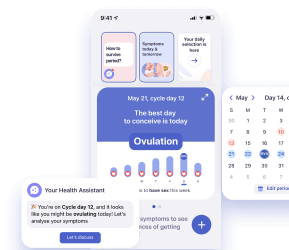Femia > Health Library > Getting Pregnant > Trying to conceive > How to conceive a boy: Exploring methods and understanding the chances
How to conceive a boy: Exploring methods and understanding the chances

- Updated Mar 2, 2025
- Published
CRAFTED BY HUMAN
Crafted by human At Femia, we provide accurate and up-to-date information at every stage of your journey, from trying to conceive, pregnancy and postnatal support. All content is created by a real person based on in-depth research and own professional experience. Femia ensures that you will receive expert advice, strict accuracy and a personalized approach from our authors/medical experts. Learn more about our editorial policy.
FACT CHECKED
Fact checked At Femia Health, we maintain the highest standards of editorial excellence in delivering content focused on helping you conceive, guiding you through pregnancy, and supporting you postpartum. Explore our content review principles to learn how we ensure the accuracy and quality of our health and lifestyle tips for every stage of your journey.
Many couples may hope for a certain sex when they start trying to have a baby, and methods like the Shettles method are popular options for those hoping to influence the outcome naturally. While there is no strong scientific evidence that any of the natural methods work, they are generally harmless to try.
Certain medical interventions that significantly increase your chances of having a boy exist, but they are not available in every country and may involve invasive procedures.
For centuries, the idea of influencing a baby’s sex has fascinated people, leading to the rise of various methods claiming to tip the odds one way or the other. While these approaches are often still popular, most are not scientifically proven. Still, if you’re curious about how to conceive a boy, let’s explore some common methods, their effectiveness, and what science has to say about your chances.

How is a baby’s sex determined?
A baby’s sex (male or female) is determined by their chromosomes. A male baby will have XY chromosomes and a female baby will have XX*. The egg from the mother always carries an X chromosome, so the sex of the baby is determined by the father’s sperm. Some sperm will carry an X chromosome, while others carry a Y. The sex of the baby will be determined by which sperm fertilizes the egg.
According to the World Health Organization (WHO), the sex ratio, which is the amount of boys to girls born, is 105 boys to 100 girls. This gives you a 51% chance of having a baby boy.
| *Some babies are born intersex, meaning they have a different combination of chromosomes to the typical XX or XY. For the purpose of this article, when we talk about sex, we’ll refer to the typical XY for a male and XX for a female. |
Chances of having a boy naturally
Statistically, each time you conceive, there’s an almost 50:50 chance of having a boy. However, throughout history, there have been periods where the sex ratio has fluctuated unexpectedly, leading scientists to explore possible genetic or environmental influences. For example, in England, the percentage of boys born rose from 50.8% in 1900 to 51.6% after World War I and II. While this increase seems small, on a population scale, it resulted in a significant number of additional boys being born.
Could your chances of having a boy be inherited?
A 2008 study by Newcastle University analyzed 927 family trees, covering over half a million people, and suggested that men may inherit a tendency to have more sons or daughters. So, a man with many brothers may be more likely to have sons himself, possibly due to producing more Y chromosome-carrying sperm. This inherited tendency could help explain the fluctuations in sex ratio observed throughout history.
| An important note |
|---|
| While it’s perfectly normal to have a preference for a boy or girl, an intense focus can sometimes indicate underlying emotional concerns. If you have any such concerns, consider reaching out to your healthcare provider. They will be able to offer non-judgemental support and guidance. |
Popular methods to conceive a boy
Some popular methods people try in hopes of conceiving a boy include timing intercourse and making dietary changes. However, it’s important to remember that none of these approaches are scientifically proven to work.
- Shettles method. This is one of the most well-known methods that couples use to try to increase their chances of having a boy. Shettles, an American obstetrician and a pioneer in the IVF field, created a method that he claimed would increase your chances of having a boy. (See below for a detailed description of this method)
- Dietary changes. Some people claim that eating different foods can influence your chances of having a boy. A 2008 study looked at the diet of 740 women around the time they got pregnant and the sex of their baby. It found that women who had the highest intake were 1.5 times more likely to have a boy than women who had the lowest intake. These women also had a significantly higher intake of potassium. However, it’s important to note that this study only included Caucasian women, and while it suggests a possible link between diet and the baby’s sex, it doesn’t establish a direct cause.
👉Find out more: Fertility diet: What to eat to boost your chances of getting pregnant
How to increase chances of having a boy naturally
If you’re hoping to naturally increase your chances of having a boy, here are a few popular tips to try. Remember, though: none of these are scientifically proven, and while it might be fun to try, the sex of your baby is mostly down to chance.
- Timing intercourse around ovulation. The Shettles method suggests that having sex as close to ovulation as possible gives you a higher chance of having a boy.
- Deeper penetration during intercourse. Some believe this gives Y-chromosome sperm, which are thought to be faster but less resilient, a better chance by depositing them closer to the cervix and egg.
- Avoiding heat and tight clothing. For men, keeping things cool might help sperm quality. While there is no evidence it will affect the sex of your baby, heat exposure or tight clothing may affect sperm production. So, looser clothing and cooler environments is generally thought to be beneficial.
- Adapt your diet. Some people claim that a woman’s diet influences the pH of her reproductive tract. A more alkaline reproductive tract is said to favor Y carrying sperm, so eating foods high in potassium, like bananas and eggs, and a protein-based diet could help you to conceive a boy.
@femia.fertility Can you really choose your baby's gender? Let's explore the facts with our expert Natasha L. Osho. Join the conversation: are you wishing for a baby boy or girl? Share your hopes and thoughts in the comments! #boyorgirl💙💗 #tryingtoconceive #ttcjourney ♬ Chill Vibes - Tollan Kim
Can timing help you get pregnant with a boy?
The Shettles Method is probably the most well-known technique couples use to try to influence their baby’s sex. Developed in the 1960s by American obstetrician Landrum Shettles, this method focuses on timing intercourse around ovulation to sway the odds. In his book, Shettles claims an 80% success rate for couples hoping to have a boy.
How the method works:
The method is based on the idea that Y-carrying sperm, the chromosome needed for a boy, are smaller and lighter than X-carrying sperm. Shettles claims that this means Y sperm are faster but less resilient and don’t live as long.
- Track ovulation. Use an ovulation tracking app, like Femia, or keep a note of ovulation symptoms in a journal to track your cycle for a few months until you are able to establish a pattern. Ovulation can be difficult to predict, especially for those with irregular cycles.
- Avoid tight clothing. Men should avoid tight underwear, as Shettle believed that too much heat can kill off the more fragile Y-carrying sperm in the testicles.
- Abstain from sex. Don’t have sex during the four to five days before ovulation.
- Time your intercourse. Shettles claims that if you want to have a boy, then you need to have sex on the day of ovulation or as close to ovulation as possible. Try two to three days before ovulation if you want a girl.
- Consider your positioning. Lastly, the method claims that depositing the sperm as close as possible to the cervix using deeper penetrating positions during sex gives the faster Y sperm an advantage in the race to the egg.
👉Find out more: How long after implantation bleeding can I test for pregnancy?
What the science says:
- Shettles’ method is based on the idea that Y and X chromosome-carrying sperm have different shapes and behave differently.
- More recent research has found no significant differences in the shape of X and Y sperm.
- Research on the timing of intercourse and its impact on a baby’s sex has produced mixed results.
- A 1979 New England Journal of Medicine (NEJM) study suggested that having sex two days after ovulation increased the chances of having a boy.
- A meta-analysis by Gray found more boys were born to women who had sex three to four days before ovulation.
- A 1995 NEJM study, which followed 221 women trying to conceive, concluded that timing intercourse around ovulation had no effect on the baby’s sex.
As you can see, there’s no scientific consensus around timing affecting your baby’s sex. While it can be fun to experiment, the most important thing is not to put too much pressure on yourself, your partner, or your relationship in the process.
How to conceive a baby boy surely: Medical interventions
There are certain medical interventions that can increase your chance of having a boy. However, in many countries it is illegal to choose the sex of your baby, and these interventions are only performed in medically necessary cases.
Possible medical interventions:
- Preimplantation genetic diagnosis (PGD). This is used during IVF to test embryos for genetic conditions, and it can also be used to determine the sex of the embryo. Only embryos of the desired sex are then transferred. This method has a 99.9% success rate for having a boy.
- Sperm sorting. This involves separating the X- and Y-carrying sperm before insemination. The success rate for having a boy is 78–85%.
These methods are typically used for medical reasons, like avoiding sex-linked genetic disorders, rather than for personal preference. They are not available everywhere and can be quite controversial, especially when used for non-medical purposes.

Questions from the Femia community
Can my diet really help me conceive a boy?
There's no strong scientific evidence that diet can influence a baby’s sex, though some believe that eating potassium-rich foods or increasing your food intake before conceiving might help. However, these claims are mostly anecdotal and shouldn’t be a reason to make any major lifestyle changes.
Are there any medical procedures I can use to choose a boy?
Yes, techniques like sperm sorting and IVF with PGD can significantly increase the chances of having a boy, but they are generally used only for medical reasons. PGD can offer an almost guaranteed outcome, but it is only available in a few countries and comes with a high price tag. Additionally, it requires going through IVF, which has its own set of discomforts and risks.
Do men with certain lifestyles have a higher chance of having boys?
There’s little evidence that lifestyle factors like wearing loose clothing or avoiding heat can significantly influence the sex of a baby, but these are often recommended for overall sperm health. The only thing that might influence a man's ability to have a son is their family history. It has been suggested that men with lots of brothers are more likely to have sons.
The bottom line
While there are many methods and myths about how to conceive a boy, there’s limited scientific evidence that any natural approach really works. In reality, you have a 50:50 chance of having a boy or girl. And, while it’s perfectly normal to hope for one sex over the other, the primary focus should always be on having a healthy pregnancy and baby.
Medical options that offer a much higher success rate do exist, but in some countries, they are either illegal or reserved for medical reasons. In countries where methods are more readily available, they often come with a hefty price tag and involve invasive procedures like IVF.
If you or your partner’s desire for a certain sex feels overwhelming, it’s a good idea to talk to your healthcare provider. They can offer impartial, non-judgmental advice to help you navigate your feelings and decide the best path forward.
References
- “Boxers or Briefs? Loose-fitting Underwear May Benefit Sperm Production.” Harvard T.H. Chan School of Public Health, 9 Aug. 2018, www.hsph.harvard.edu/news/press-releases/does-underwear-style-affect-sperm-production.
- Gellatly, Corry. “Trends in Population Sex Ratios May Be Explained by Changes in the Frequencies of Polymorphic Alleles of a Sex Ratio Gene.” Evolutionary Biology, vol. 36, no. 2, Dec. 2008, pp. 190–200, https://doi.org/10.1007/s11692-008-9046-3.
- “Gender Ratio.” Our World in Data, ourworldindata.org/gender-ratio. Accessed 7 Oct. 2024.
- Grant, Valerie J. “Entrenched Misinformation About X and Y Sperm.” BMJ, vol. 332, no. 7546, Apr. 2006, p. 916.3, https://doi.org/10.1136/bmj.332.7546.916-b.
- Gray, R. H. “Natural Family Planning and Sex Selection: Fact or Fiction?” American Journal of Obstetrics and Gynecology, vol. 165, no. 6, Dec. 1991, pp. 1982–84, https://doi.org/10.1016/s0002-9378(11)90558-4.
- Harlap, Susan. “Gender of Infants Conceived on Different Days of the Menstrual Cycle.” New England Journal of Medicine, vol. 300, no. 26, June 1979, pp. 1445–48, https://doi.org/10.1056/nejm197906283002601.
- Mathews, Fiona, et al. “You Are What Your Mother Eats: Evidence for Maternal Preconception Diet Influencing Foetal Sex in Humans.” Proceedings of the Royal Society B: Biological Sciences, vol. 275, no. 1643, Apr. 2008, pp. 1661–68, https://doi.org/10.1098/rspb.2008.0105.
- Nhgri. “Chromosomes Fact Sheet.” Genome.gov, 9 Mar. 2019, www.genome.gov/about-genomics/fact-sheets/Chromosomes-Fact-Sheet.
- Rai, Pragya, et al. “Global Sex Selection Techniques for Family Planning: A Narrative Review.” Journal of Reproductive and Infant Psychology, vol. 36, no. 5, Aug. 2018, pp. 548–60, https://doi.org/10.1080/02646838.2018.1508871.
- Shettles, Landrum B. “Sex Selection.” American Journal of Obstetrics and Gynecology, vol. 124, no. 4, Feb. 1976, pp. 441–42, https://doi.org/10.1016/0002-9378(76)90115-0.
- “The Shettles Method of Sex Selection.” Embryo Project Encyclopedia, 3 Apr. 2019, embryo.asu.edu/pages/shettles-method-sex-selection.
- Wilcox, Allen J., et al. “Timing of Sexual Intercourse in Relation to Ovulation — Effects on the Probability of Conception, Survival of the Pregnancy, and Sex of the Baby.” New England Journal of Medicine, vol. 333, no. 23, Dec. 1995, pp. 1517–21, https://doi.org/10.1056/nejm199512073332301.

Wondering if you can eat crab while pregnant? Discover if crab and crab legs are safe to eat during pregnancy, along with tips for enjoying seafood safely.

Learn how to get short-term disability approved while pregnant, including tips for consulting with your doctor, gathering necessary documentation, and filing a claim.

When do you go to the hospital for labor? Discover common signs of labor and learn how to distinguish early signs from active labor to find the answer.

